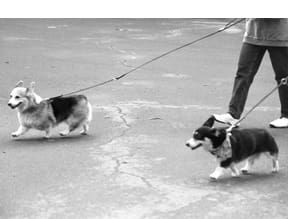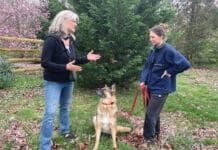What to do when spouses disagree about the dog
Help! I really need suggestions to help sway my 75-year-old husband toward positive training methods for our six-month-old puppy.
Before we got our pup, we agreed upon positive training, and even bought and read your book, The Power of Positive Dog Training, among others. Now, after three months, my husband has decided that the training methods we’ve been using don’t work because the pup still (in my words) acts like a puppy.

Here’s an example: The pup has been taught (when he grabs hats, gloves, shoes, and the like) to drop it and accept an exchange item (one of many toys lying around the floor, which I grab and use to initiate the exchange). He doesn’t play tug with the human item but gives it up freely, and I think that is success. I believe he’s beginning to know that the stuff he grabs is not for him.
My husband believes the pup is still grabbing the human items because he hasn’t been punished. Hubby has built a coin-can for the times the pup counter-surfs. You get the picture.
The pup already ducks his head when my husband moves his hands. Pup is a combination guy: cautious, fearful, bright, willful, willing, funny. Husband is classic senior male homo sapien – a bit impatient with occasional tendencies toward grouchy.
I fear that I might have to give up the pup rather than subject him to this. I am heartbroken and need suggestions. Each time the pup acts up it is a condemnation of my training.
Pat Miller responds:
Applause to you for using positive methods – successfully – with your pup! The trade game is a perfect solution to teach pups to bring us “forbidden objects” rather than carrying them off and chewing on them.
Your husband is, indeed, undermining your training program. The ultimate goal of positive training is to create a relationship with your well-behaved dog that is built on trust and respect. Your pup is learning that he can trust you, but not other humans – at least, not your husband. So, until we can convert your husband to a more positive training philosophy, you need to look for ways to better manage your pup’s behavior so your husband doesn’t have a chance to punish him.
For starters, I would pick up all the miscellaneous items to minimize the trade-game conflict between you, your husband, and the pup. Next, I would keep countertops and tables scrupulously cleared, so the pup has no reason to counter-surf. I would also use management tools such as tethers, leashes, and crates to manage the pup’s behavior and keep him safe from punishment when you are not there to supervise.
Deb Jones’ videos – especially “Click and Go” (basic clicker training) and “Click and Fix” (using clicker training to resolve behavior problems) are the two I’d suggest for showing your husband how clicker training works.
Another fun one to watch is Karen Pryor’s “Clicker Magic.” In fact, you might have him watch the Pryor video first; it’s very entertaining and a great overview of all the various things that clicker training can accomplish, while Jones’ are terrific “how-to” tapes.
Remember that your husband has probably been practicing these old-fashioned punishment-based training methods for 70-plus years. Well-practiced behaviors can take a long time to change, so be patient with him while you protect your puppy.
Also remember that positive reinforcement works beautifully with humans, too! Look for ways to reward your husband when he does use positive methods with your puppy, and remember to find and use rewards that are meaningful to him.
If all else fails, you might seriously consider rehoming the pup. I agree that I would not want to raise a dog in an environment that caused him to become fearful.
Good luck – and let us know how you do with turning your husband into a crossover trainer!
———-
Big dog gets more and more aggressive on walks
My friend got a very large mixed breed dog about a year ago. She lives in a condominium and has to walk the dog many times a day since there is no yard.
For about the first six months, all went well. My friend cannot point to an incident or recall anything that might have caused her dog’s behavior to change, but he has gradually become less able to pass other dogs without reacting. Every time her dog sees another dog while out walking, he becomes agitated, whines, barks, lunges, etc.
I’ve suggested trying to keep the dog at a distance from his triggers, desensitization, using the “treats from heaven” to try to convince the dog that seeing other dogs is a good thing, and even simply turning and walking the other way when they see another dog approaching. Unfortunately, this dog has to be walked in a neighborhood full of dogs; it’s not possible to keep him at a distance from his triggers. My friend is considering an electric collar, to my dismay.
Do you have any suggestions for positive training methods to use in this situation?
Pat Miller responds:
It’s unfortunate that your friend waited this long to address the problem; if she had used positive reinforcement all along there’s a good chance the problem behavior might never have occurred.
You can tell her that there are usually three causes of this behavior:
1. He wants to greet, visit, and play with the other dogs. She doesn’t let him (nor would I) or doesn’t always let him, perhaps even gives him collar “corrections,” so he gets frustrated and stressed, which expresses itself as aggression.
2. Her reaction to his stress and frustration is to verbally and/or physically reprimand him, which stresses him more, leading to more aggression, and convincing him that bad things happen when other dogs are around. This causes him to start to dislike other dogs.
3. At age one-year-plus, he is reaching maturity, which is when some dogs, especially assertive ones, may begin to exhibit signs of inter-dog aggression, even if they were neutered at an appropriate age.
I would suggest the following:
1. If the dog is not already neutered, do so immediately. It takes a few weeks for the effects of the hormones to subside, but the lack of testosterone definitely helps reduce a male dog’s “drive” to act aggressively.
2. If she has not already taken the dog through a basic good manners class taught by a skilled positive trainer, she should do so immediately. If she has already taken a basic class with him, she should enroll him in the next level.
3. If the dog is suitable, she should take him to a reputable doggie daycare facility two or more times a week, to give him the opportunity to interact naturally and freely with other dogs without the frustration of leash restraint. A good daycare facility, with knowledgeable, experienced managment, will be able to safely determine if he is a good candidate for socialized daycare.
4. If he does well at daycare, she should try to find a dog park to take him to at least once or twice a week in addition to the daycare.
5. I would also suggest that she read several good books on dog aggression and behavior, including:
• Aggression in Dogs, by Brenda Aloff
• The Other End of the Leash, by Patricia McConnell
• The Culture Clash, by Jean Donaldson
• Dogs Are From Neptune, by Jean Donaldson
6. Finally, as you suggested, I would suggest that your friend implement a program of counter-conditioning and desensitization to change the dog’s opinion of the presence of other dogs from stressful to positive.
Counter-conditioning and desensitization can work even if the reaction is triggered from time to time – it just may take longer. Tell her that using a shock collar is likely to just reinforce his current opinion that being around other dogs is a bad thing. If necessary, she should engage the services of a good, positive trainer who can help her modify this behavior – sooner, rather than later when it gets even worse and will be more difficult to fix.
———-
My two dogs can’t live together peacefully anymore!
I really need some advice/ideas/wisdom about my two dogs. Right now, I’m so discouraged about them.

I adopted Molly, age three, two years ago from our local Humane Society. If she’s not a purebred Mini-Aussie, there’s not much else in her. To say she is energetic doesn’t begin to describe her. (I joke that her anatomy includes a caffeine gland.) She’s very smart, and a super dog in her comfort zone, but her comfort zone is very small. My efforts to extend her comfort zone have ranged from mildly successful to nightmarish.
Her difficult behaviors range from acting like she wants to take the head off of someone at the door (though she’s never bitten anyone) to submissive urination. I’ve been able to marginally improve some of these things. She does get exercise, but probably not enough for her energy level.
About a year ago, I was very happy to be able to successfully introduce little puppy Cocoa into our household. This little cutie (who looks a lot like a pint-sized Chesapeake Bay Retriever) fought her way back from distemper, which ruined my early socialization plans, but I’m happy to say she loves dogs and people alike.
Molly and Cocoa are not exactly buddies, but they have coexisted mostly peacefully and will play together. Now that Cocoa is an adult, however, their squabbles seem to be on the increase. Sometimes their squabble seems to be over me and this is solved if I walk away. However, they have had a few knock-down drag-outs that have resulted in blood (Cocoa’s; Molly is much quicker) and would have been truly frightening if they were big dogs.
The bad squabbles seem to occur when Molly gets very frantic about something and Cocoa, bugged at these shenanigans, will growl at her as if to say, “Knock it off, already.” Molly replies “Oh, yeah? Make me!” and they’re off.
I have read a lot about dog behavior, but lacking much experience, I can’t seem to figure out how to handle this correctly. I am very committed to both of these dogs.
Pat Miller responds:
Aggression between your own dogs can be incredibly stressful and heartbreaking. Good for you for your commitment to putting some serious work into fixing it!
It seems paradoxical that dogs, who are naturally pack animals, can have so much trouble getting along with each other. It is really very common, though, in part due to the fact that we keep them in such unnatural environments. We humans are a social species, too, and look how much trouble we can have getting along!
Several things about your dilemma:
It’s devilishly difficult to help diagnose aggression long-distance since there are so many variables in the behavior as well as the observer’s analysis of it. Without watching your dogs’ body language with my own eyes, it’s pretty tricky to make an accurate guess about what’s going on.
That said, I’ll give you my opinion anyway. However, I think you should seriously consider consulting a behaviorist who can see your dogs in action. Generally, the longer two dogs have a history of antagonistic behavior, the more deeply ingrained it is, and the more resistant to modification. Bringing in a behaviorist sooner, rather than later, increases your likelihood of success.
Remember to interview and investigate your behaviorist thoroughly. College degrees do not make or break a good behaviorist. There are Veterinary Behaviorists, Certified Applied Animal Behaviorists, and behaviorists – trainers who do behavior work but don’t have the degree. Any of them can be good or bad. Find one with a good track record, whose training and behavior modification philosophies match yours.
As for the dogs’ behavior . . . My guess is that Molly tolerated Cocoa until the puppy reached adulthood. As Cocoa matured and gained more confidence in her own position, she became less willing to defer to Molly. I don’t know when you had her spayed, but there is some evidence that spaying can increase female dog aggression because the female hormones are reduced, increasing the influence of the remaining testosterone in her system. I’m not convinced about that because the assertive behavior generally increases as a female reaches maturity – which coincidentally is the same time many people have their dogs spayed.
Either way, I would suggest creating a very calm, structured household, with rowdy play delegated to the outdoors where there is more open space, and where resource guarding of you is less likely to occur. Practice close observation of both dogs’ body language for early signs of tension. Intervene early, with a cheerful “Go to your place!” for both dogs, when you see tension building – not just for the one you perceive to be the aggressor. If early intervention doesn’t head off disaster, then a more formal (still cheerful) time-out for both dogs may be in order; send them to separate rooms for a short cooling-off period.
Better management of situations that are likely to cause conflict can help. For example, calm, controlled passage through doorways to the outside can reduce arguments – not because dogs hold doorways in such high regard, but because the excitement of going in and out is likely to generate high arousal, which can cause conflict.
I would also suggest veterinary exams for both dogs, including full panel thyroid tests (clinically normal but low thyroid levels may contribute to aggression) to be sure there are no medical conditions contributing to stress, which contributes to aggression. You could also explore lower protein diets, and discuss alternative approaches with a veterinarian who is comfortable with both Eastern and Western modalities of treatment, to see if there are any herbal, homeopathic, or flower essence remedies that might help your dogs be more compatible. Other possibilities to investigate that can be very helpful are related to touch: calming massage, acupressure, and/or TTouch techniques.
More exercise can help take the wind out of their sails. You may need to exercise them separately to prevent squabbles. Controlled exercise (rather than frenzied) is ideal, since it reinforces the dogs’ deference to you. For example: “Sit and wait while I throw the ball, go get it when I ask, bring it back, drop it, and sit and wait for me to throw again.”
I would also recommend reading Jean Donaldson’s two books, The Culture Clash and Dogs Are From Neptune, and either Brenda Aloff’s Aggression in Dogs, or James O’Heare’s Canine Aggression Workbook. All of these books can give you greater insight into the workings of your dogs’ brains, and the last two can help you set up specific behavior modification protocols.
One last note: Stay safe if a fight does erupt. Dog-dog aggression doesn’t usually translate to intentional aggression toward humans, but it’s easy to get bitten if you jump into the middle of a fracas. (See “Break It Up,” WDJ December 2002.)






